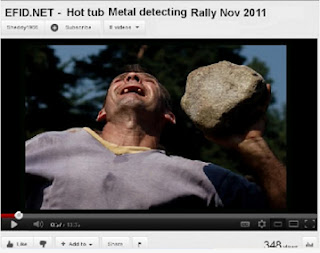.
In a post on my main blog ("
Focus on UK Metal Detecting: Archaeological Iron, Hedge Fodder or Discrimination") I discuss what artefact hunters are throwing away:
UKDN Member "Hawyoo" (Sep 02, 2012 10:33 am) asks: "
What should i keep[?]":
Hi all.I find a lot of what some people may call junk.I seem to keep it
all.Most is just rusty old iron but some of it looks interesting. [...] i
am thinking they may just be a little something in there.
Obviously most of us can see that among the iron objects taken by
artefact hunters from archaeological sites will be a number of fragments
of iron archaeological items, hardly "junk". One UKDN respondent however calls these artefacts "
HedgeFodder (HF)"
implying he just throws this sort of material into the hedges
(interesting that some tekkies are concerned about contamination of the
rural landscape with metal in contaminated Green Waste, while others are
quite happy to litter the hedgerows with metal fragments produced by
the hobby). Another member admonishes: "
Firstly you shouldn't be digging rusty old iron should you? try a little discrimination".
This is followed by a series of horror stories on what people have "pulled from the scrap bins". Including this one from a
"Puffin" (Sun Sep 02, 2012 5:46 pm):
Even after 7 years, a few months ago I had to pull a Saxon/Viking 4 way
strap divider out of my scrap bin. Many because of a post on here, you
really need to be 120% sure of what you are weighing in!
"Weighing in" of course is tekkie slang for what artefact hunters
discard from their artefact collections and sell by weight for melting
down for scrap. How many tens of thousands of archaeological items end
up that way as a result of this hobby each year?
Of course anything that made its way into a tekkie scrap bin, but is
pulled out weeks, months or years later because it is recognised to have
been something of significance has by then irrevocably lost the
information about its findspot.
Carried out in this way the hobby of
artefact hunting is destroying vast quantities of archaeological information
because many of these people which current UK policy lets loose to
pillage archaeological sites to gratify their collecting hobby are
ignorant (or careless) of just what it is they are finding and what
information they should be observing, collecting and recording. Having a
Portable Antiquities Scheme has not made the slightest dent on this
problem.
Now, if the PAS was doing its job, it would be on the UKDN forum like a
shot to give an answer to the question posted there.
In answer to "what should I
keep [when rummaging in the archaeological record for collectables]?"
the only possible answer is, "every piece of archaeological evidence".
Anything less is destruction, and if you do not know what is and what
is not archaeological evidence, then leave the archaeological record
well alone.
Surely, in order to instil 'best practice', this is the point they should be making EVERY TIME this question arises in the practice of ten thousand people in fifteen years. Why aren't they?
.

